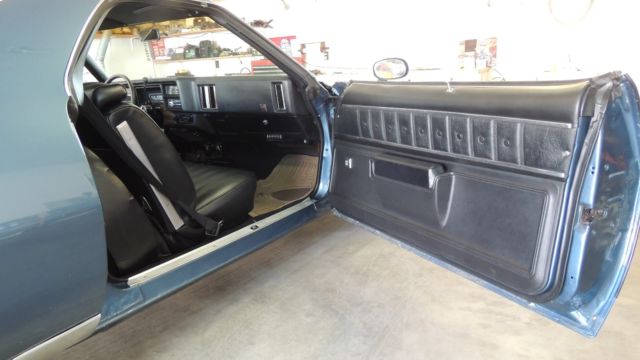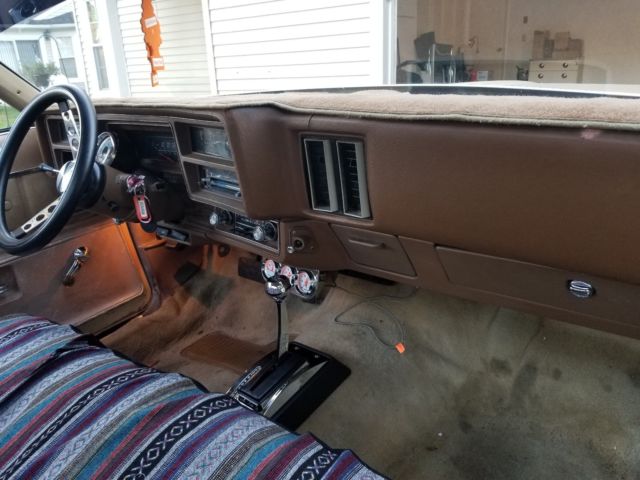

The 1959 El Camino was promoted as the first Chevrolet pickup built with a steel bed floor instead of wood. The quirky Level Air suspension option, in its second and final year, was listed as available, but was almost never seen on any Chevrolet model, much less an El Camino. The somewhat soft passenger car suspension of the base model left the vehicle level without a load, in contrast the Ranchero, where standard 1100-pound rated heavy duty rear springs gave it a distinct rake when empty. The El Camino's payload rating ranged from 650–1,150 lb (290–520 kg), with gross vehicle weights ranging from 4,400–4,900 lb (2,000–2,200 kg) depending on powertrain and suspension. The 119 in (3,000 mm) wheel-base was 1.5 inches (38 mm) longer, and overall length for all 1959 Chevrolets was up to 210.9 in (5,360 mm). Its chassis featured Chevrolet's "Safety-Girder" X-frame design and a full-coil suspension, both introduced in the 1958 model year. It came in a single trim level, its exterior using the mid-level Bel-Air's trim, and the interior of the low-end Biscayne. Unlike the Brookwood wagon and a sedan delivery variant, the El Camino was available with any full-sized Chevrolet drivetrain. Highly stylized, it initially sold 50% more briskly than the more conservative Ranchero, some 22,000 to 14,000. Like the Ranchero, it was based on an existing and modified platform, the new-for-1959 Brookwood two-door station wagon, itself based on the redesigned full-sized Chevrolet of that year. According to Chevrolet stylist Chuck Jordan, GM Harley Earl had suggested a coupé pickup in 1952. The El Camino was introduced for the 1959 model year two years after the Ford Ranchero. Van Nuys, California, United States, ( Van Nuys Assembly) Norwood, Ohio, United States, ( Norwood Assembly) Lakewood, Georgia, United States, ( Lakewood Assembly) Janesville, Wisconsin, United States, ( Janesville Assembly) īaltimore, Maryland, United States, ( Baltimore Assembly)įlint, Michigan, United States, ( Flint Assembly) The original El Camino and Ranchero would compete directly only in the 1959 model year. In 1959, Chevrolet responded with the El Camino to compete with Ford's full-sized Ranchero. of an automobile platform based coupé utility. In 1957, Ford introduced the Ranchero, and established a new market segment in the U.S. The body style did not reappear on the American market until the release of the 1957 Ford Ranchero.īoth the coupé utility and the similar open-topped roadster utility continued in production, but the improving economy of the mid- to late-1930s and the desire for improved comfort saw coupé utility sales climb at the expense of the roadster utility until, by 1939, the latter was all but a fading memory.

General Motors’ Australian subsidiary Holden also produced a Chevrolet coupé utility in 1935, and Studebaker produced the Coupé Express from 1937 to 1939.
#1977 el camino classic carburetor series
Bandt went on to manage Ford's Advanced Design Department, being responsible for the body engineering of the XP, XT, XW, and XA series Ford Falcon utilities. Ford designer Lew Bandt developed a suitable solution, and the first coupé utility model was released in 1934. įord Australia was the first company to produce a coupé utility as a result of a 1932 letter from the wife of a farmer in Victoria, Australia, asking for "a vehicle to go to church in on a Sunday and which can carry our pigs to market on Mondays". The concept of a two-door vehicle based on a passenger car chassis with a tray at the rear began in the United States in the 1920s with the roadster utility (also called "roadster pickup" or "light delivery") models. Renamed Caballero in 1978, it was also produced through the 1987 model year. GMC's badge engineered El Camino variant, the Sprint, was introduced for the 1971 model year. Production resumed for the 1964–1977 model years based on the Chevelle platform, and continued for the 1978–1987 model years based on the GM G-body platform.Īlthough based on corresponding General Motors car lines, the vehicle is classified in the United States as a pickup. Introduced in the 1959 model year in response to the success of the Ford Ranchero coupé utility, its first run, based on the Biscayne's B-body, lasted only two years. Unlike a standard pickup truck, the El Camino was adapted from the standard two-door Chevrolet station wagon platform and integrated the cab and cargo bed into the body.

The Chevrolet El Camino is a coupé utility vehicle that was produced by Chevrolet between 1959––1987.


 0 kommentar(er)
0 kommentar(er)
